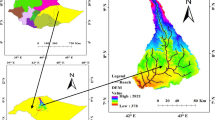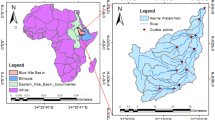Abstract
At a watershed scale, soil erosion occurs at a spatially variable rate, posing a significant danger to long-term resource management. The most serious issue has long been regarded as soil erosion. As a result, estimating soil loss and identifying the critical area for implementing optimum management techniques are essential to the programme's success. A numerical model called the sediment-rainfall-watershed area model (SRWA) is built using a spatially distributed RUSLE-based SDR hybridized model to estimate sediment yields in the upper Brahmaputra River watershed. The developed model has been calibrated and validated from 2001 to 2007 and 2008 to 2014, respectively. For the entire period, the statistical performance of the proposed SRWA model and the SDR-RUSLE-based model reveals a correlation coefficient of 0.93 and a Nash–Sutcliffe efficiency coefficient of 0.84. This demonstrates that the SRWA model may assess sediment yield at any upper Brahmaputra basin watershed/sub-watershed outlet.










Similar content being viewed by others
References
Alewell C, Borrelli P, Meusburger K, Panagos P (2019) Using the USLE: chances, challenges and limitations of soil erosion modelling. Int Soil Water Conserv Res 7(3):203–225
Andersson L (2010) Soil loss estimation based on the USLE/GIS approach through small catchments-a minor field study in tunisia. TVVR10/5019
Bewket W, Teferi E (2009) Assessment of soil erosion hazard and 412 prioritization for treatment at the watershed level: case study in the Chemoga watershed, Blue Nile basin. Ethiop Land Degrad Dev 20(6):609–622
Bhattacharyya R, Ghosh BN, Mishra PK, Mandal B, Rao CS, SarkarDasLalithaHatiFranzluebbers DKMKAJ (2015) Soil degradation in India: challenges and potential solutions. Sustainability 7(4):3528–3570
De Rosa P, Cencetti C, Fredduzzi A (2016) A GRASS tool for the Sediment Delivery Ratio mapping. PeerJ Preprints 4:e2227v1
Dent FJ (1980) Major production systems and soil-related constraints in Southeast Asia. In: Priorities for alleviating soil-related constraints to food production in the tropics, pp 79–106
Duru U, Arabi M, Wohl EE (2018) Modeling stream flow and sediment yield using the SWAT model: a case study of Ankara River basin. Turk Phys Geogr 39(3):264–289
Fistikoglu O, Harmancioglu NB (2002) Integration of GIS with USLE in assessment of soil erosion. Water Resour Manage 16(6):447–467
Ganasri BP, Ramesh H (2016) Assessment of soil erosion by RUSLE model using remote sensing and GIS-A case study of Nethravathi basin. Geosci Front 7(6):953–961
Gelagay HS (2016) RUSLE and SDR model based sediment yield assessment in a GIS and remote sensing environment; a case study of Koga watershed, Upper Blue Nile basin. Ethiop Hydrol Curr Res 7(2):239
Girmay G, Moges A, Muluneh A (2020) Estimation of soil loss rate using the USLE model for Agewmariayam Watershed, northern Ethiopia. Agric Food Secur 9(1):1–12
Hazarika N, Das AK, Borah SB (2015) Assessing land-use changes driven by river dynamics in chronically flood affected Upper Brahmaputra plains, India, using RS-GIS techniques. Egypt J Remote Sens Space Sci 18(1):107–118
Heathman GC, Larose MYRIAM, Ascough JC (2009) Soil and water assessment tool evaluation of soil and land use geographic information system data sets on simulated stream flow. J Soil Water Conserv 64(1):17–32
Hosseini FS, Choubin B, Mosavi A, Nabipour N, Shamshirband S, Darabi H, Haghighi AT (2020) Flash flood hazard assessment using ensembles and Bayesian-based machine learning models: application of the simulated annealing feature selection method. Sci Total Environ 711:135–161
Hurni H, Meyer K (2002) A world soils agenda: discussing international actions for the sustainable use of soils. Geographica Bernensia, Bern
Immerzeel W (2008) Historical trends and future predictions of climate 446 variability in the Brahmaputra basin. Int J Climatol J R Meteorol Soc 28(2):243–254
Issaka S, Ashraf MA (2017) Impact of soil erosion and degradation on water quality: a review. Geol Ecol Landsc 1(1):1–11
Jabbar YC, Yadav SM (2022) Development of reservoir capacity loss model using bootstrapping of sediment rating curves. ISH J Hydraul Eng 28(sup1):14–26
Jain MK, Kothyari UC (2000) Estimation of soil erosion and sediment yield using GIS. Hydrol Sci J 45(5):771–786
Kamaludin H, Lihan T, Ali Rahman Z, Mustapha MA, Idris WMR, Rahim SA (2013) Integration of remote sensing, RUSLE and GIS to model potential soil loss and sediment yield (SY). Hydrol Earth Syst Sci Discuss 10(4):4567–4596
Lasdon LS, Waren AD, Jain A, Ratner M (1978) Design and testing of a generalized reduced gradient code for nonlinear programming. ACM Trans Math Softw (TOMS) 4(1):34–50
Li X, Wu B, Wang H, Zhang J (2011) Regional soil erosion risk assessment in Hai Basin. Yaogan Xuebao J Remote Sens 15(2):372–387
Li P, Zang Y, Ma D, Yao W, Holden J, Irvine B, Zhao G (2020) Soil erosion rates assessed by RUSLE and PESERA for a Chinese Loess Plateau catchment under land-cover changes. Earth Surf Proc Land 45(3):707–722
Luo J, Xie J (2010) Parameter estimation for nonlinear Muskingum model based on immune clonal selection algorithm. J Hydrol Eng 15(10):844–851
Mani P, Kumar R, Chatterjee C (2003) Erosion study of a part of Majuli River-Island using remote sensing data. J Indian Soc Remote Sens 31(1):12–18
Mirzaei G, Soltani A, Soltani M, Darabi M (2018) An integrated data-mining and multi-criteria decision-making approach for hazard-based object ranking with a focus on landslides and floods. Environ Earth Sci 77(16):1–23
Mohan S (1997) Parameter estimation of nonlinear Muskingum models using genetic algorithm. J Hydraul Eng 123(2):137–142
Murtagh BA, Saunders MA (1978) Large-scale linearly constrained optimization. Math Program 14(1):41–72
Nash JE, Sutcliffe JV (1970) River flow forecasting through conceptual models part I—A discussion of principles. J Hydrol 10:282–290
Niazkar M, Zakwan M (2021) Assessment of artificial intelligence models for developing single-value and loop rating curves. Complexity 2021:1–21
Poirier C, Poitevin C, Chaumillon E (2016) Comparison of estuarine 479 sediment record with modelled rates of sediment supply from a western European catchment since 1500. CR Geosci 348(7):479–488
Pradeep GS, Krishnan MV, Vijith H (2015) Identification of critical soil erosion prone areas and annual average soil loss in an upland agricultural watershed of Western Ghats, using analytical hierarchy process (AHP) and RUSLE techniques. Arab J Geosci 8(6):3697–3711
Renard KG (1997) Predicting soil erosion by water: a guide to conservation planning with the Revised Universal Soil Loss Equation (RUSLE). United States Government Printing, Washington
Restrepo JD, Kjerfve B, Hermelin M, Restrepo JC (2006) Factors controlling sediment yield in a major South American drainage basin: the Magdalena River, Colombia. J Hydrol 316(1–4904):213–232
Risse LM, Nearing MA, Laflen JM, Nicks AD (1993) Error assessment in the universal soil loss equation. Soil Sci Soc Am J 57(3):825–833
Roddy BP (2010) The use of the sediment fingerprinting technique to quantify the different sediment sources entering the Whangapoua Estuary, North Island, in New Zealand (Doctoral dissertation, University of Waikato)
Saha SK (2003) Water and wind induced soil erosion assessment and monitoring using remote sensing and GIS. Satellite remote sensing and GIS applications in agricultural meteorology. Jul 7:315–330
Singh G, Babu R, Chandra S (1981) Soil loss and prediction research in India. In: Central Soil and Water Conservation Research Training Institute Bulletin, vol 9, T–12
Singh R, Phadke VS (2006) Assessing soil loss by water erosion in Jamni River basin, Bundelkhand region, India, adopting universal soil loss equation using GIS. Current Sci 90:1431–1435
Smith S, Lasdon L (1992) Solving large sparse nonlinear programs using GRG. ORSA J Comput 4(1):2–15
Thomas J, Joseph S, Thrivikramji KP (2018) Assessment of soil erosion in a tropical mountain river basin of the southern Western Ghats, India using RUSLE and GIS. Geosci Front 9(3):893–906
Toprak ZF, Eris E, Agiralioglu N, Cigizoglu HK, Yilmaz L, AksoyCoskunAndicAlganci HHGGU (2009) Modeling monthly mean flow in a poorly gauged basin by fuzzy logic. Clean: Soil, Air, Water 37(7):555–564
Triharyanto E (2018) The application of biofilm biofertilizer-based organic fertilizer to increase available soil nutrients and spinach yield on dry land (a study case in lithosol soil type). In: IOP conference series: earth and environmental science, vol 200, no. 1. IOP Publishing, p 01200
Vale SS, Fuller IC, Procter JN, Basher LR, Smith IE (2016) Characterization 513 and quantification of suspended sediment sources to the Manawatu River, New Zealand. Sci Total Environ 543:171–186
Wawer R, Nowocien E, Podolski B (2005) Eal and calculated kusle erobility factor for selected Polish soils. Pol J Environ Stud 14(5):655–658
Wenzel HG Jr, Melching CS (1987) An Evaluation of the MULTISED (multiple watershed storm water and sediment runoff simulation) simulation model to predict sediment yield. Construction Engineering Research Lab (ARMY), Champaign
Williams JR, Berndt HD (1977) Sediment yield prediction based on watershed hydrology. Transactions of the ASAE 20(6):1100–1104
Wischmeier WH, Smith DD (1978) Predicting rainfall erosion losses: a guide to conservation planning (No. 537). In: Department of Agriculture, Science and Education Administration
Xu K, Peng HQ, Rifu DGJ, Zhang RX, Xiao H, & Shi Q (2015) Sediment yield simulation using SWAT model for water environmental protection in an agricultural watershed. Applied Mechanics and Materials, vol 713. Trans Tech Publications Ltd, pp 1894–1898
Yadav A, Joshi D, Kumar V, Mohapatra H, Iwendi C, Gadekallu TR (2022) Capability and robustness of novel hybridized artificial intelligence technique for sediment yield modeling in Godavari River. India Water 14(12):1917
Yan R, Zhang X, Yan S, Chen H (2018) Estimating soil erosion response to land use/cover change in a catchment of the Loess Plateau, China. Int Soil Water Conserv Res 6(1):13–22
Zakwan M, Ahmad Z (2021) Analysis of sediment and discharge ratings of Ganga River. India Arab J Geosci 14(19):1–15
Author information
Authors and Affiliations
Corresponding author
Ethics declarations
Conflict of interest
The authors confirm there is no conflict of interest in the manuscript.
Additional information
Edited by Dr. Robert Bialik (ASSOCIATE EDITOR) / Dr. Michael Nones (CO-EDITOR-IN-CHIEF).
Rights and permissions
Springer Nature or its licensor (e.g. a society or other partner) holds exclusive rights to this article under a publishing agreement with the author(s) or other rightsholder(s); author self-archiving of the accepted manuscript version of this article is solely governed by the terms of such publishing agreement and applicable law.
About this article
Cite this article
Sil, B.S., Pathan, S.A. Development of a numerical model for sediment yield for the upper Brahmaputra River basin using optimization technique. Acta Geophys. 71, 2423–2438 (2023). https://doi.org/10.1007/s11600-022-01002-3
Received:
Accepted:
Published:
Issue Date:
DOI: https://doi.org/10.1007/s11600-022-01002-3




